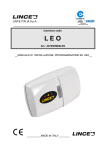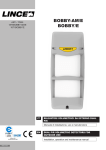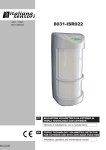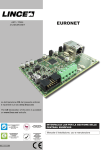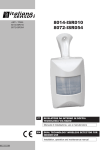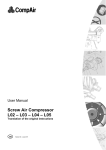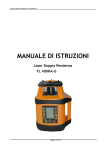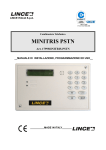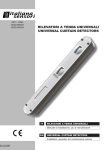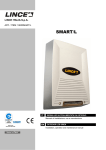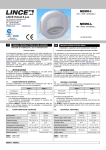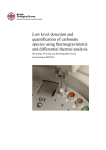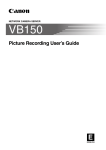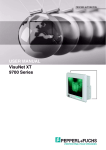Download File istruzioni
Transcript
LINCE ITALIA S.p.A. ART. / ITEM: 4043GR868BOBBY GR868 BOBBY La dichiarazione CE del presente articolo è reperibile su sito www.lince.net. The CE declaration of this item is available on www.lince.net website. IT BOBBY RADIO 868 MHz TRIPLA TECNOLOGIA Manuale di installazione, uso e manutenzione QUALITY MANAGEMENT SYSTEM UNI EN ISO 9001:2008 REG.N.4796 CERTIFICATION 100% MADE IN ITALY IT01.IT/1189.015.V ENVIRONMENTAL MANAGEMENT SYSTEM UNI EN ISO 14001:2004 REG.N.4796-E OCCUPATIONAL HEALTH AND SAFETY MANAGEMENT SYSTEM OHSAS 18001:2007 REG.N.4796-I EN TRIPLE TECHNOLOGY BOBBY RADIO 868 MHz Installation, operation and maintenance manual MADE IN ITALY LINCE ITALIA S.p.A. - Istruzioni originali - - Translation of the original instructions (original instructions in Italian) - INDICE CONTENTS 1.DESCRIZIONE................................................................................................... 2 1.1 CARATTERISTICHE GENERALI............................................................ 2 1.2 CARATTERISTICHE TECNICHE............................................................ 3 1.3 GRAFICO DI COPERTURA (vista in pianta)........................................... 3 1.5 IDENTIFICAZIONE DELLE PARTI ESTERNE........................................ 4 1.6 IDENTIFICAZIONE DELLE PARTI INTERNE......................................... 5 2.INSTALLAZIONE............................................................................................... 6 2.1 AVVERTENZE GENERALI...................................................................... 6 2.2 CONSIGLI PER L’INSTALLAZIONE........................................................ 6 2.3 MONTAGGIO DEL RILEVATORE........................................................... 6 2.3.1 Installazione sul muro................................................................... 7 2.3.2 Installazione sul palo.................................................................... 7 2.3.3 Regolazione della distanza di rilevazione.................................. 10 3.MEMORIZZAZIONE......................................................................................... 11 4. FUNZIONE TEST............................................................................................. 11 4.1.1 Fase di Test................................................................................ 11 5.INIBIZIONE....................................................................................................... 11 6. DOPPIA TRASMISSIONE................................................................................ 12 7.SUPERVISIONE............................................................................................... 12 8. CONFIGURAZIONE DIP-SWITCH................................................................... 12 9. ESEMPIO DI RILEVAMENTO.......................................................................... 13 10. RICERCA DEI GUASTI E/O MALFUNZIONAMENTI ..................................... 14 11. MANUTENZIONE E VERIFICHE PERIODICHE.............................................. 15 11.1 PULIZIA ESTERNA DEL RILEVATORE................................................ 15 12. SMALTIMENTO E ROTTAMAZIONE............................................................... 15 12.1 DISINSTALLAZIONE............................................................................. 15 1.DESCRIPTION................................................................................................... 2 1.1 GENERAL FEATURES........................................................................... 2 1.2 TECHNICAL FEATURES........................................................................ 3 1.3 COVERED AREA PATTERN (plan view) ................................................ 3 1.5 EXTERNAL PARTS IDENTIFICATION.................................................... 4 1.5 INTERNAL PARTS IDENTIFICATION..................................................... 5 2.INSTALLATION.................................................................................................. 6 2.1 GENERAL PRECAUTIONS.................................................................... 6 2.2 INSTALLATION ADVICES....................................................................... 6 2.3 MOUNTING THE DETECTOR................................................................ 6 2.3.1 Wall mounting............................................................................... 7 2.3.2 Pole mounting.............................................................................. 7 2.3.3 Detection range adjustment....................................................... 10 3.STORAGE........................................................................................................ 11 4. TEST MODE..................................................................................................... 11 4.1.1 Test mode................................................................................... 11 5. STAND-BY MODE............................................................................................ 11 6. DOUBLE TRANSMISSION.............................................................................. 12 7.SUPERVISION................................................................................................. 12 8. DIP-SWITCHES CONFIGURATION................................................................. 12 9. DETECTING EXAMPLE................................................................................... 13 10. TROUBLE SHOOTING.................................................................................... 14 11. MAINTENANCE AND PERIODIC CHECKS.................................................... 15 11.1 CLEANING THE EXTERNAL PART OF THE DETECTOR................... 15 12. DISPOSAL AND SCRAPPING......................................................................... 15 12.1 DISMANTLING...................................................................................... 15 Le informazioni riportate in questo manuale sono state compilate con cura, tuttavia LINCE ITALIA S.p.A. non può essere ritenuta responsabile per eventuali errori e/o omissioni. LINCE ITALIA S.p.A. si riserva il diritto di apportare in ogni momento e senza preavviso, miglioramenti e/o modifiche ai prodotti descritti nel presente manuale. Consultare il sito www. lince.net per le condizioni di assistenza e garanzia. LINCE ITALIA S.p.A. pone particolare attenzione al rispetto dell’ambiente. Tutti i prodotti ed i processi produttivi sono progettati con criteri di eco-compatibilità. Il presente articolo è stato prodotto in Italia. The information in this manual has been issued with care, but LINCE ITALIA S.p.A. will not be responsible for any errors or omissions. LINCE ITALIA S.p.A. reserves the right to improve or modify the products described in this manual at any time and without advance notice.Terms and conditions regarding assistance and the product warranty can be found at LINCE ITALIA’s website www.lince.net. LINCE ITALIA S.p.A. makes it a priority to respect the environment. All products and production processes are designed to be eco-friendly and sustainable. This product has been Made in Italy. 1.DESCRIZIONE 1.DESCRIPTION Il rilevatore da esterno BOBBY è composto da due sensori infrarosso passivi dual PIR e da un sensore a microonda a 10,525GHz. L’elettronica è stata progettata per garantire le massime prestazioni in ambiente esterno e a temperature rigide. L’elettronica del rilevatore è orientabile e permette di ottenere una copertura orizzontale distribuita su 150°. Il fascio infrarosso inferiore è orientabile anche verticalmente e questo permette di ottenere un range di copertura compreso tra 3 m e 12 m. The BOBBY outdoor detector consists of two dual PIR passive sensors and a 10.525GHz microwave sensor. The particularly evolved electronics has been designed to guarantee the maximum performances in external and rigid temperatures environment. The electronic parts of the detector are adjustable and allow to get a horizontal coverage distributed on 150°. The lower infrared beam is even vertically adjustable and it allows to get a detection range between 3 m and 12 m. 1.1 1.1 • • • • • • • • 2 CARATTERISTICHE GENERALI Funzionamento in abbinamento con i seguenti prodotti LINCE: -- Centrale 4092E-PLUSTOSCA -- Ricevitore universale 4052GR868RX8 -- Tastiera ricevente 4047GR868TAST -- Tastiera ricetrasmittente 4071GR868TAST/TRX Basso consumo di corrente. Circuito di rilevazione batteria scarica. Sensore DUAL PIR a lente di Fresnel più sensore a microonda. Funzione TEST della durata di 4 minuti durante i quali il rilevatore effettua una trasmissione ad ogni rilevazione senza andare in inibizione; Microswitch antisabotaggio contro l’apertura del coperchio e lo strappo del rilevatore dal muro. Tre tipi di trasmissione radio: -- ALLARME -- SABOTAGGIO -- BATTERIA SCARICA Funzione inibizione LED e trasmissione per risparmio batteria (vedi pag.11). • GENERAL FEATURES Working with the following LINCE devices: -- Control panel 4092E-PLUSTOSCA -- Receiver 4052GR868RX8 -- Keyboard with built-in receiver 4047GR868TAST -- Keyboard with built-in transceiver 4071GR868TAST/TRX • Low consumption. • Low battery detecting circuit. • DUAL PIR sensor with Fresnel lens and microwave sensor. • TEST function lasting 4 minutes during which the detector makes a transmission for every detection without going inhibition; • Anti tamper microswitch to prevent unauthorized cover opening and wall removing. • 3 radio transmission types: -- ALARM -- TAMPER -- LOW BATTERY • LED indicator and transmission inhibition for low consumption purpose (see pag.11). LINCE ITALIA S.p.A. Nota: il ricevitore universale 4052GR868RX8 può essere anche associato a qualsiasi altra centrale antifurto disponibile sul mercato. Le tastiere 4047GR868TAST e 4071GR868TAST/TRX sono utilizzabili con le centrali: • 4002EUROPLUS5 • 4003EUROPLUS10 • 4102EUROPLUS5/E • 4078E-PLUS10MST Notes: the universal receiver 4052GR868RX8 can be used in association with any other alarm control panel available on the market. The keyboards 4047GR868TAST and 4071GR868TAST/TRX can be used in association with the following control panels: • 4002EUROPLUS5 • 4003EUROPLUS10 • 4102EUROPLUS5/E • 4078E-PLUS10MST Not all items are available in your area. Contact your dealer for details. 1.2 CARATTERISTICHE TECNICHE 1.2 • Doppia trasmissione “DTE”. • Tripla tecnologia da esterno. • Due sensori PIR e una microonda con funzionamento programmabile. • Frequenza della microonda: 10,525 GHz. • Sensori PIR a doppio elemento, basso consumo, con filtro UV. • Regolazione micrometrica del fascio inferiore (sistema brevettato). • Lente di Fresnel realizzata con materiale resistente ai raggi UV. • Ampiezza orizzontale del fascio di rilevazione 60°. • Escursione orizzontale della copertura: ± 45°. • Staffa di fissaggio a parete in acciaio inox. • Staffe di fissaggio a palo in acciaio inox (disponibile su richiesta, art. 001801/00102AA). • Grado di protezione IP44. • Contenitore in policarbonato resistente ai raggi UV. • Temperatura di esercizio: -25 °C ÷ +60 °C • Portata: 3 ÷ 12 m. • Alimentazione: Batteria al Litio 2/3 A 3.6 V. • Assorbimento in stand-by : 15 µA. • Assorbimento in trasmissione: 50 mA. • Frequenza radio 868 MHz • Dimensioni: 81x56x189 mm. • • • • • 1.3 1.3 GRAFICO DI COPERTURA (vista in pianta) • • • • • • • • • • • • • • • TECHNICAL FEATURES “DTE” double trasmission. Outdoor triple technology detector. Two PIR sensors and one microwave with adjustable function. MW frequency: 10.525 GHz. Infrared sensors, low consumption double element and UV filter. Fine adjustment of the lower beam (patented system). UV rays resistant Fresnel lens. Horizontal beam detection: 60°. Horizontal detection excursion: ± 45°. Stainless steel wall fixing support. Stainless steel pole fixing brackets (available on request, item 001801/00102AA). Degree of protection: IP44. UV resistant polycarbonate case. Operating temperature: -25 °C ÷ +60 °C. Range: 3 ÷ 12 m. Power Supply: 2/3A Lithium battery 3.6 V. Power consumption in stand-by: 15 µA. Power consumption in transmission: 50 mA. Radio frequency 868 MHz Dimensions: 81x56x189 mm. COVERED AREA PATTERN (plan view) Fig. 1 Le zone in grigio non possono essere coperte; le zone tratteggiate potranno essere coperte ruotando il meccanismo interno. Grey zones can not be protected; the coverage of dashed zones can be obtained with rotation of internal mechanism. 3 LINCE ITALIA S.p.A. Le prestazioni ottimali sono riferite ad una altezza di installazione pari a circa 120 cm Se nell’area di copertura c’è la possibilità che vi sia presenza di piccoli animali si consiglia di installare il rilevatore ad una altezza tale da evitare che il fascio superiore rilevi la presenza dell’animale stesso. The optimal performances refer to a 120cm height standard installation. If there are small animals inside covered area, we advise to install the detector in such way that the upper beam cannot be reached by the animal. 1.5 1.5 IDENTIFICAZIONE DELLE PARTI ESTERNE EXTERNAL PARTS IDENTIFICATION Tabella 1 Table 1 Part. Identificazione Ref. A Viti di fissaggio del supporto rilevatore sulla staffa. A Bracket screws. B Vite di fissaggio del coperchio con lente. B Cover mounting screw. C Coperchio con lente di Fresnel. C Cover with Fresnel lens. D Pomello con vite metrica di regolazione PIR basso. D Adjusting knob for lower PIR (PIR2). E Supporto elettronica. E Electronic holder. F Microinterruttore con funzione antistrappo (solo se fissato con la vite A). F Anti Tamper function micro switch (only if A screw is mounted). G Staffa in acciaio inox. G Stainless steel support. H Staffe per fissaggio a palo (non fornite art.: 001805/00102AA). H Stainless steel pole mounting brackets (not supplied item: 001805/00102AA). I Vite metrica M4 x 6 inox per fissaggio staffe ad “U” (q.tà 4) contenute nel kit accessorio art. 001805/00102AA. I Stainless Steel metric screw M4 x 6 for “U” brackets fixing (4pcs ) enclosed into kit item 001805/00102AA. L Viti metriche M4 x 10 inox (q.tà 4) contenute nel kit accessorio art. 001805/00102AA. L Stainless Steel metric screw M4 x 10 enclosed into kit item 001805/00102AA. H Identification I E L H F A G I A C D B Fig. 2 4 LINCE ITALIA S.p.A. 1.6 IDENTIFICAZIONE DELLE PARTI INTERNE 1.5 INTERNAL PARTS IDENTIFICATION Tabella 2 Rif. Table 2 Identificazione Ref. Identification 1 Microswitch apertura ed antistrappo 1 Antitamper Microswitch 2 Batteria al litio da 3.6 V, 2/3A, 2100mAh (art.: 001515/00198AA) 2 3.6V, 2/3A, 2100mAh 001515/00198AA) 3 LED Rosso di trasmissione radio (durante il test si accende ad ogni trasmissione radio sia essa di antisabotaggio che di allarme) 3 Red LED = radio transmission (during the test turns on every radio transmission for tamper or for alarm) 4 LED Giallo di MW ( durante il test si accende ad ogni rilevazione di microonda) 4 Yellow LED = MW LED (during the test turns on every microwave detection) 5 LED Verde di IR (durante il test si accende quando entrambi i sensori infrarossi rilevano una presenza.) 5 Green LED = IR LED (during the test turns on when both IR sensors detect a presence) 6 Antenna (lasciarla il più possibile verticale e lontana dalla piastra di fissaggio) 6 Antenna (leave it as more vertical and far from the fixing support as possible) 7 Jumper J1 per esclusione manuale dei LED 7 Jumper to the exclusion of the LEDs 8 PIR1 8 PIR1 lithium 9 Trimmer MW per la regolazione della sensibilità MW 9 Trimmer MW for MW sensibility setting 10 Dip-Switch 10 Dip-Switch 11 PIR2 11 PIR2 battery (item.: 1 2 4 8 7 6 9 10 3 5 11 Fig. 3 NOTA: i LED saranno attivi esclusivamente quando il rilevatore è in modalità test. Al termine del test i LED saranno in modalità sempre spento; per riattivarli al fine di verificare il funzionamento del rilevatore, occorre aprire e richiudere il coperchio (apertura e ri-chiusura dell’antisabotaggio). NOTE: LED’s are enabled only during TEST mode. When TEST mode ends, LED’s are always powered off. To reactivate them in order to verify the detector is working, open and close the cover (opening and closing antitamper microswitch). 5 LINCE ITALIA S.p.A. 2.INSTALLAZIONE 2.INSTALLATION 2.1 2.1 AVVERTENZE GENERALI Prima dell'installazione verificare le seguenti condizioni: • la parete non deve presentare avvallamenti o sporgenze eccessive; • installare il rilevatore su superfici rigide prive di vibrazioni; • evitare il posizionamento del rilevatore vicino a fonti di calore o alla luce diretta del sole; • evitare la riflessione dell’energia elettromagnetica su ampie superfici quali, ad esempio, specchi, pareti metalliche, etc.; • evitare di puntare il rilevatore su lampade fluorescenti o comunque di porlo nelle immediate vicinanze delle stesse. • Per i collegamenti è consigliabile utilizzare un cavo schermato e, preferibilmente, un cavo per ogni rilevatore. • Separare i cavi dell’impianto di allarme da quelli della rete elettrica. Il rilevatore può essere installato in ambiente esterno (secondo quanto prescritto dalla normativa EN 50131-1 nella classe ambientale IV). • • 2.2 Evitare di puntare il rilevatore verso oggetti in movimento o, se ciò risultasse inevitabile, prestare la massima cura nelle regolazioni al fine di evitare falsi allarmi. Apporre sempre il coperchio con lente di Fresnel prima di effettuare le prove di copertura, senza lente il rilevatore non funziona. CONSIGLI PER L’INSTALLAZIONE È buona norma, prima di installare il rilevatore BOBBY fare una attenta valutazione dell’area da proteggere, evitando siti dove possano esserci piante a ridosso del rilevatore e/o piante che crescendo possano arrivare all’altezza del rilevatore stesso creando così fastidiosi falsi allarmi. La conformazione del terreno è un altro elemento importante; se nell’area da proteggere sono presenti dossi, animali anche relativamente piccoli, potrebbero essere rilevati da entrambi i fasci IR con conseguente generazione di falso allarme. L’altezza di fissaggio del rilevatore è un fattore fondamentale per il corretto funzionamento, se si installa ad una altezza inferiore al metro è possibile che animali di media taglia possano essere rilevati, altresì se si esagera nell’altezza di fissaggio (oltre 1,3 m) si avrà una zona non protetta inferiore troppo marcata a discapito quindi della sicurezza. 2.3 MONTAGGIO DEL RILEVATORE L’altezza di installazione deve essere compresa tra i 100 cm min. ed 130 cm max (terreno non in pendenza). Se nell’area di copertura c’è la possibilità che vi sia presenza di animali di medie dimensioni si consiglia di installare il rilevatore ad una altezza tale da evitare che il fascio superiore rilevi la presenza dell’animale stesso (v. fig. 22, 23, 24). Fissare la staffa di ancoraggio a muro, o su palo, stabile ed immune da oscillazioni. • Effettuare le regolazioni del rilevatore agendo sul pomello D di regolazione del PIR 2 (fig. 2). • Fissare il supporto rilevatore ad innesto sulla staffa ed avvitare le due viti A. • Applicare la copertura frontale fissandola con la vite B (fig. 2). Evitare di puntare il rilevatore verso oggetti in movimento o, se ciò risulta inevitabile, prestare la massima cura nelle regolazioni al fine di evitare falsi allarmi. Montare sempre il coperchio con lente di Fresnel prima di effettuare le prove di copertura, senza lente il rilevatore non può funzionare correttamente. 6 GENERAL PRECAUTIONS Before starting the installation, make sure that: • the wall does not have any pronounced depressions or protrusions; • install the detector on rigid surfaces, free of vibrations; • avoid to fix the detectors near to heat sources or at direct sunlight; • avoid electromagnetic energy reflection on wide surfaces such as mirrors, metal walls, etc.; • avoid to fix the detector in front of fluorescent lamps or in proximity of them. • Connections shielded cable is suggested and one cable per detector is preferred. • Separate the alarm system cables from the mains cables. The detector can be installed outdoors (according to the Class IV EN 50131-1). • • Avoid to direct the detector towards moving objects or, if impossible, please take care in adjusting the detector in order to avoid false alarms. Be sure to install the cover with Fresnel lens before the detector testing. Without cover, the detector doesn’t work. 2.2 INSTALLATION ADVICES Before installing BOBBY detector, it is very important to carefully evaluate the area to be protected. To avoid false alarms, do not install the detector behind big trees /bushes. Also pay particular attention to the ground conformation: if in the area to be protected are bumps or small animals, both could be detected by both IR beams resulting in the generation of false alarm. The detector installation height is a fundamental factor for the correct working. If the installation height is lower than 1 m, it is possible that small animals can be detected; if the installation height is greater than 1.3 m, there will be a great unprotected area in the down portion of the detected area. 2.3 MOUNTING THE DETECTOR Installation height must be between 1 m and 1.30 m (not tilted ground). If medium-sized animals might enter the coverage area, we recommend installing the detector at a height that allows you to prevent the upper beam from detecting their presence (see fig. 22, 23, 24). Fix the support on a wall or on a stable pole. • • • Lift up or take down the PIR 2 (low) using the adjusting knob D to choose the protected area as shown in fig. 2. Fix the detector support and screw it with the screws A. Hook up and mount the front cover fixing it with screw B (fig. 2). Avoid to direct the detector towards moving objects or, if impossible, please take care in adjusting the detector in order to avoid false alarms. Be sure to install the cover with Fresnel lens before testing the detector. Without cover, the detector doesn’t work correctly. LINCE ITALIA S.p.A. Attenzione: la massima distanza di copertura (12 m) si ottiene solamente installando il rilevatore ad un altezza di 120 cm. Important: the maximum detection range (12 m) is obtained only if the installation height is 120 cm. Fig. 4 2.3.1 • • Installazione sul muro 2.3.1 Effettuare 4 fori nel muro ed inserire i tasselli. Fissare ora la staffa al muro o, se su palo, seguire le indicazioni di fig. 5. • • Nel fissare la staffa al muro fare attenzione alla perpendicolarità rispetto al terreno. Wall mounting Make four holes on the wall and insert the plugs. To fix the metallic support on the pole, please see fig. 5. Fix the metallic support on the wall perpendicularly to the ground Fig. 5 2.3.2 Installazione sul palo 2.3.2 Nel caso di fissaggio su palo procedere come illustrato in figura fissando la staffa metallica principale alle due staffe da palo (opzionali) Pole mounting Fix the support onto the mounting support with supplied screws. Place the brackets (not included) around the pole and fasten using the pole locking screws. Fig. 6 7 LINCE ITALIA S.p.A. • Poggiare il corpo del rilevatore sulla staffa e farlo scendere fino in fondo per far coincidere i fori di fissaggio del corpo con quelli della staffa • Locate the detector body on the metallic support and slide it down, then fix it using the supplied screws. Adjust PIR2, close the detector hooking up the cover downwards, as shown in figure. Fix the cover using the metric screw. Dopo aver effettuato le regolazioni del PIR 2 chiudere il rilevatore inserendo il coperchio con lente dall’alto verso il basso come illustrato quindi avvitarlo tramite la relativa vite metrica. Fig. 7 MONTAGGIO CORRETTO Montare il rilevatore in posizione verticale e perpendicolarmente al terreno. Fig. 8 8 CORRECT INSTALLATION Position the detector vertically and perpendicularly to the ground LINCE ITALIA S.p.A. MONTAGGIO NON CORRETTO (rilevatore inclinato verticalmente) Se il rilevatore viene montato inclinato verso il basso la portata può risultare ridotta. WRONG INSTALLATION (detector tilted downwards) If the detector is not installed perpendicularly to the ground, as shown, operational reliability may result decreased. Fig. 9 MONTAGGIO NON CORRETTO (rilevatore inclinato verticalmente) Se il rilevatore viene montato inclinato verso l’alto il PIR basso non garantisce la copertura in prossimità del suolo mentre il PIR superiore copre una zona troppo alta. WRONG INSTALLATION (detector tilted upwards) If the detector is not installed perpendicularly to the ground, as shown, operational reliability may result decreased Fig. 10 WRONG INSTALLATION Take care to install the detector perpendicularly to the groung. MONTAGGIO NON CORRETTO Accertarsi che il rilevatore sia montato perpendicolarmente rispetto al terreno. Fig. 11 Il rilevatore BOBBY è equipaggiato con speciali filtri per i disturbi dei raggi solari; nei limiti del possibile è comunque consigliata l’installazione evitando il sole diretto BOBBY is designed to avoid any light disturbance. However too strong light as direct sunlight may cause unstable condition of detector, for example direct sunlight. It’s recommended to avoid such type of installation. Fig. 12 9 LINCE ITALIA S.p.A. 2.3.3 Regolazione della distanza di rilevazione Tramite il pomello di regolazione è possibile regolare il fascio del PIR basso in modo da ottenere distanze di rilevazione come di seguito riportate. 2.3.3 Detection range adjustment Use adjusting knob to adjust PIR2 detection length. Fig. 13 Posizione PIR2 Distanza PIR2 Position Range A 3m A 3m B 4m B 4m C 7m C 7m D 12 m D 12 m Il trimmer “MW” regola la sensibilità della microonda (aumenta in senso orario). Use MW trimmer to adjust “MW” detection range (clockwise to increase). Posizione A Position A Posizione E Position E Fig. 14 Fig. 15 10 LINCE ITALIA S.p.A. 3.MEMORIZZAZIONE 3.STORAGE Il rilevatore è utilizzabile con i seguenti prodotti: • 4052GR868RX8 • 4092E-PLUSTOSCA • Centrale EUROPLUS equipaggiata con 4071GR868TAST/ TRX o con 4047GR868TAST. Per la memorizzazione del dispositivo fare riferimento al manuale della ricevente utilizzata The detector is usable with the following products: • 4052GR868RX8 • 4092E-PLUSTOSCA • EUROPLUS control panel equipped with 4071GR868TAST/ TRX or 4047GR868TAST. For storing details please refer to the product manual of the used receiver. 4. FUNZIONE TEST 4. TEST MODE Dopo aver alimentato il rilevatore, attendere almeno 1 minuto prima di effettuare le prove di copertura per permettere ai rivelatori infrarossi di stabilizzarsi. Durante la fase di TEST (v. par. 4.1) al fine di ottenere una simulazione reale, liberare la zona protetta, evitando che più persone si muovano all’interno della zona stessa. Dopo 30÷40 secondi di quiete, e prima dello scadere del tempo di test, entrare nell’area di rilevazione. Verificare il funzionamento del rilevatore con l’ausilio dei LED di segnalazione. After powered the detector, wait at least 1 minute before testing detection range, because it needs to be stabilized. To get a real simulation during TEST mode (see paragraph 4.1), verify that the coverage area of the detector is free from obstacles in movement. Wait 30÷40 seconds and try to enter into the area covered by the detector, pay attention to cross the beams. Verify the correct operation of the 2 PIR’s through the alarm LED’s. Una volta ottenuta la rilevazione, occorre attendere non meno di 7÷8 secondi prima di provare ad essere rilevati di nuovo. Per conoscere l’area protetta fare riferimento ai grafici di copertura (pag. 3 e 10). After the first alarm it needs to wait about 7÷ 8 seconds before triggering a new detection. To know the covered area by the detector please refer to the covered area pattern (pages 3 and 10). Dopo 4 minuti il rilevatore esce automaticamente dalla modalità test. After 4 minutes TEST function the detector will be automatically ended. 4.1.1 4.1.1 Fase di Test Si può entrare in questa funzione aprendo e richiudendo lo switch antisabotaggio; entro 5s i LED si attiveranno ed avranno il seguente significato: LED Rosso: si accende ad ogni trasmissione radio sia essa un sabotaggio che una rilevazione di allarme. LED Giallo: si accende ogni qualvolta la microonda rileva la presenza. LED Verde: si accende ogni qualvolta uno dei due IR rileva la presenza. Dopo circa 4 minuti il rilevatore esce automaticamente dalla modalità test ed i LED si spengono. Per provare la zona di copertura del rilevatore è importante che il rilevatore sia chiuso e con il coperchio con lente di Fresnel inserito. Effettuare la prova di funzionamento facendo attenzione ad interrompere i fasci dell’infrarosso perpendicolarmente (vedi pag. 3). Una volta effettuate le prove di rilevazione e copertura radio il rilevatore è pronto per il funzionamento, al termine della fase di test il funzionamento del rilevatore potrà essere verificato sulla centrale o sulla ricevente. Test mode Enter this mode pressing and holding anti tamper switch; within 5 seconds, LEDs will be activated and they will have the following meaning: Red LED: radio transmission for alarm or anti tamper. Yellow LED: microwave indicator LED. Green LED: PIR indicator LED. After about 4 minutes, test mode ends automatically and the detector is ready to work normally. To verify the detection range, remember to close the detector cover. During the test, pay attention to cross the beams orthogonally (see pag. 3). Once the detecting and radio test are completed, the detector is ready to work. At the end of the tests the operation can be verified on the Control Panel either on the Receiver. 5.INIBIZIONE 5. STAND-BY MODE Nel funzionamento normale (LED spenti) il rilevatore attiva automaticamente la funzione INIBIZIONE per risparmio batteria; questo comporta che se l’ambiente è frequentato il rilevatore rimarrà inibito fino a quando non trascorreranno almeno 3 minuti di quiete (nessuna rilevazione). Questa importante funzione evita che il rilevatore trasmetta di continuo situazioni di allarme ad ogni passaggio di persone. During normal operation (LED’s off) the detector automatically enters inhibition mode to save battery. During this time the detector does not transmit (any possible alarm) unless the covered area is clear for at least 3min . Per verificare il funzionamento del rilevatore quindi occorrerà attendere almeno tre minuti senza che alcuna persona venga rilevata. To check whether the detector works correctly, it needs to wait at least 3 minutes without detection (no movements for 3 minutes at least). 11 LINCE ITALIA S.p.A. 6. DOPPIA TRASMISSIONE 6. DOUBLE TRANSMISSION La Doppia Trasmissione dell’Evento “DTE” è una funzione che aumenta notevolmente la sicurezza in quanto il rilevatore BOBBY, quando rileva un evento d’allarme, trasmette subito una prima segnalazione alla centrale/ricevente e, in un tempo casuale controllato dal microprocessore (4 ÷ 10s), ritrasmette la stessa segnalazione. Double event transmission “DTE” it is a safety function. When an alarm occurs, the detector transmits alarm condition to the control panel; it transmits again after 4÷10s. 7.SUPERVISIONE 7.SUPERVISION La supervisione è utile per aumentare il livello di sicurezza dell’impianto; i rilevatori con tale funzione attivata inviano, ad intervalli regolari, un breve segnale di esistenza in vita alla ricevente. Di default la funzione di supervisione non è attiva sul rivelatore; per attivarla occorre effettuare una procedura durante la fase di “self-test” iniziale. Il lampeggio dei LED nel “self- test” iniziale avviene nel seguente modo (supervisione disattiva): • 1 lampeggio LED rosso, • 1 lampeggio LED verde, • 1 lampeggio LED giallo. Per attivare la supervisione premere velocemente tre volte il microswitch di antisabotaggio entro i 30 secondi di self- test iniziale (rif. A, Fig 3) e verificare che i tre LED lampeggino nel seguente modo: • 2 lampeggi LED rosso, • 2 lampeggi LED verde, • 2 lampeggi LED giallo. Per disattivare la supervisione, eseguire la stessa azione utilizzata per attivarla. Supervision is usefull to improve the security system; the detectors with this function activated send, at regulars intevals, a short signal of “ existence in life” to the receveir. By default the monitoring function is not active on the detector; to activate the function is necessary follow a sequence during the power-on self-test phase. The LEDs flashing during the power-on self-test takes place in the following way (monitoring disabled): • One flash of the red LED, • one flash of the green LED, • one fash of the yellow LED. To activate the supervision function press quickly the tamper during the 30 seconds of power-on self-test (ref. A, Fig 3) and verify that the three LEDs flashing as follow: • Two flashes of the red LED, • two flashes of the green LED, • two flashes of the yellow LED. To disable the supervision function, carry out the same action used for activate it. NOTE: 1.Le impostazioni della supervisione rimangono memorizzate anche se la pila viene rimossa. 2. Per verificare lo stato della funzione servirsi delle segnalazioni dei LED durante la fase di self-test. 3.Per attivare la fase di self-test, successivamente alla prima attivazione del rilevatore, togliere la pila per qualche secondo e re-inserirla. 4. E’ necessario attivare la supervisione sulla ricevente facendo riferimento al relativo manuale. 8. CONFIGURAZIONE DIP-SWITCH DIP NOTES: 1. The monitoring settings are kept in the device memory even in case of battery removal. 2. To verify if the function status, use the LEDs signals of the power-on self test. 3. To activate again the self-test after the first activation of the device, remove the battery for a few seconds and insert it again. 4. It is mandatory to activate the monitoring function referring to the product manual. 8. DIP-SWITCHES CONFIGURATION DIP 1 OFF Sensibilità PIR 1 bassa ON Sensibilità PIR 1 alta 1 OFF PIR1 Low sensitivity ON PIR1 High sensitivity 2 OFF Sensibilità PIR 2 bassa ON Sensibilità PIR 2 alta 2 OFF PIR2 Low sensitivity ON PIR2 High sensitivity Config. DIP 3 ON 4 OFF 3 OFF 4 ON 3 ON 4 ON DIP 3 OFF4 OFF 3 ON 4 OFF 3 OFF 4 ON 3 ON 4 ON Tipo di fun- Triplo AND: zione svolta MW + PIR 1 + PIR 2 Doppio AND: MW + PIR 1 Doppio AND: MW + PIR 2 AND + OR MW + OR dei 2 PIR Function Triple AND: MW + PIR 1+ PIR 2 Double AND: MW + PIR 1 Double AND: MW + PIR 2 AND + OR: MW + OR of 2 PIR Descrizione Occorrono le della fun- rilevazioni di zione tutti i tre sensori per ottenere lo stato di allarme. La rilevazione della MW + quella del solo PIR 1 attivano l’allarme (esclusione del PIR 2) La rilevazione della MW + quella del solo PIR 2 attivano l’allarme (esclusione del PIR 1) La rilevazione della MW + la rilevazione di uno dei due PIR attiva l’allarme (OR dei PIR + AND della MW) Function description Alarm occurs only if all three sensors detect a motion. Alarm occurs when MW+PIR2 detect a motion. (PIR1 disabled) Alarm occurs when MW+PIR1 detect a motion. (PIR2 disabled) Alarm occurs when (MW+PIR1) OR (MW+PIR2) detect a motion. (PIR1 OR PIR2 AND MW) 12 3 OFF4 OFF LINCE ITALIA S.p.A. 9. ESEMPIO DI RILEVAMENTO 9. DETECTING EXAMPLE L’esempio si riferisce al rilevatore settato in triplo AND. The example refers to the detector set in triple AND. ( 1 ) NESSUN ALLARME L’animale viene rilevato da due delle tre tecnologie (PIR basso e MW) per cui l’allarme NON si attiva. ( 1 ) NO ALARM The pet is detected only by two of the three sensor elements (PIR low and MW). The alarm is not enabled. Fig. 17 ( 2 ) NESSUN ALLARME La persona viene rilevata da due delle tre tecnologie (PIR alto e MW) per cui l’allarme NON si attiva. ( 2 ) NO ALARM The body is detected only by two of the three sensor elements (PIR high and MW). The alarm is not enabled. Fig. 18 ( 3 ) ALARM La persona viene rilevata da tutte e tre le tecnologie (PIR basso + PIR alto + MW) per cui si attiva lo stato di allarme. ( 3 ) ALARM The body is detected by the three sensor elements (PIR low + PIR high + MW). The alarm is enabled Fig. 19 13 LINCE ITALIA S.p.A. 10.RICERCA DEI GUASTI E/O MALFUNZIONAMENTI Trouble Soluzione I LED non si accendono Verificare la corretta installazione della pila 10.TROUBLE SHOOTING Trouble Solution LEDs fail to switch on Verificare che il Jumper sia inserito Falsi allarmi Il rilevatore non è perpendicolare al terreno Make sure that the jumper is inserted False alarms The detector is not perpendicular to the ground Il PIR basso è mal regolato, raggiunge distanze superiori a quelle desiderate Check if the lower detection area is wider than your planning Check if there are objects in movement in the detection area. Oggetti in movimento nell’area protetta (biancheria stesa, rami di alberi) Il trimmer della sensibilità della MW è al massimo A volte non rileva Errata regolazione in particolare del PIR basso La sensibilità della MW è al minimo Allarmi continui dell’u- Ostacoli di medie dimensioni a scita MASK ridosso del rilevatore Aprire il coperchio, disalimentare il rilevatore (attendere circa 5 secondi), rialimentare e chiudere il coperchio immediatamente (entro 10 secondi) 14 Check the right installation of the battery MW adjustment is set at maximum level No detection, mes. someti- The Lower PIR is not properly adjusted MW adjustment is set at minimum level Continuous alarms MASK output of Medium-sized obstacles close to the detector Open the lid, disconnect the detector (wait about 5 seconds), repower and close the lid immediately (within 10 seconds) LINCE ITALIA S.p.A. 11.MANUTENZIONE E VERIFICHE PERIODICHE 11. MAINTENANCE CHECKS 11.1 PULIZIA ESTERNA DEL RILEVATORE 11.1 CLEANING THE EXTERNAL PART OF THE DETECTOR Per assicurare il corretto funzionamento del rilevatore è necessario che la lente venga mantenuta pulita. Una lente non perfettamente pulita può causare problemi di rivelazioni e/o problemi alla funzione antimask. AND PERIODIC Keep the lens clean to guarantee proper operation of the detector. A lens which is not perfectly clean may cause detection problems and/or problems to the anti-mask function. Periodicità: quando necessario o in condizione di sporcizia evidente. Materiale da utilizzare: panno - acqua senza additivi. Procedura di pulizia: Frequency: when necessary or when clearly dirty. Material to be used: cloth - water with no additives. Cleaning procedure: IMPORTANT! Do NOT use chlorine-based or abrasive products or alcohol to remove particularly noticeable dirt. ATTENZIONE! Per rimuovere sporcizie particolarmente evidenti NON utilizzare prodotti a base di cloro, prodotti abrasivi oppure alcool. 1.Pulire il coperchio e la lente con un panno inumidito con acqua. 2. Ripassare con un panno asciutto. 1. Clean the lid and the lens with a cloth dampened with water. 2. Wipe with a dry cloth. 12.SMALTIMENTO E ROTTAMAZIONE 12.DISPOSAL AND SCRAPPING 12.1DISINSTALLAZIONE 12.1DISMANTLING ATTENZIONE! Non disperdere nell’ambiente i componenti ed ogni altro materiale del prodotto. Rivolgersi a consorzi abilitati allo smaltimento ed al riciclaggio dei materiali. IMPORTANT! Do not dispose of the components or any other product material in the environment. Seek the assistance of companies authorised to dispose of and recycle waste materials. 1. Svitare le viti che tengono fisso il coperchio frontale e rimuoverlo. 2. Scollegare il rilevatore: sulla morsettiera scollegare tutti i morsetti (v. Fig. 14). 3. Dividere le parti in base alla loro tipologia e smaltirle in accordo con le leggi vigenti. 1. Unscrew the screws that fasten the front lid and remove it. 2. Disconnect the detector: disconnect all the terminals on the terminal block (see Fig. 14). 3. Divide the parts by type and dispose of them in accordance with applicable laws. 15 LINCE ITALIA S.p.A 001530/00244AG Via Variante di Cancelliera, snc 00040 ARICCIA (Roma) Tel. +39 06 9301801 Fax +39 06 930180232 [email protected] www.lince.net
















